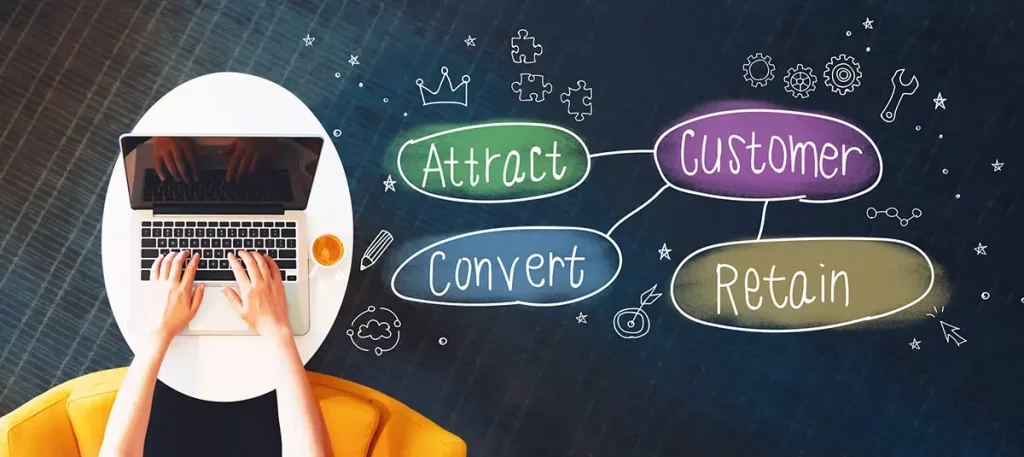Guide to MLM Customer Retention
MLM Customer Retention | Much like the childhood rhyme about keeping old friends, successful multi-level marketing (MLM) companies and field sales representatives know the secret to sales growth is to “attract new customers but keep the old. One is silver, and the other’s gold.”
With each purchase, MLM customers become more engaged with their field sales representative and more likely to make additional purchases. However, many MLM companies and their representatives focus more on acquiring new customers than they do on customer retention. As a result, they may be missing out on repeat sales that could drive significant growth. By increasing customer retention rates by only 5 percent, an MLM company can increase its profits anywhere from 25 to 95 percent.
Customer retention strategies require different focus and attention than customer acquisition, but the strategies can be executed side-by-side, giving MLM representatives the ability to create a steady stream of sales and a reliable customer base. Repeat sales to existing customers should be the foundation of an MLM representative’s business. Research shows that a small portion – 8 percent – of returning customers can drive 40 percent of retail revenue. In addition, while the probability of making a sale to a new customer is between 5 and 20 percent, the likelihood jumps to 60 to 70 percent for existing customers.
Clearly, MLM representatives need to cultivate their relationships with existing customers to build a successful business. And it all starts with understanding what customer retention is and how to measure it.

Measuring the value of customer retention
Customer retention is defined as turning one-time buyers into repeat purchasers and then into long-term loyal customers. Customer retention strategies focus on reducing the number of “one-and-done” customers. The first hurdle is to prompt the customer to make a second purchase within a relatively short amount of time. On average, 60 percent of second purchases happen within 100 days of a customer’s first purchase. Past the 100-day mark, the likelihood a customer will make a second purchase drops dramatically to just 10 percent.
The 100-day window provides a valuable insight that can help MLM companies and their field sales representatives focus their retention efforts. To gauge and guide these strategies, leverage your company’s MLM software data and reporting capabilities to track and monitor the following key metrics.
- Customer Lifetime Value (CLV): Over the lifetime of the customer relationship, the value of a customer increases with each purchase transaction. By far, the biggest jump in value occurs when a customer makes their second purchase. One of the main drivers behind the increase in value is because representatives don’t have to invest as much time in sharing information and educating existing customers. The CLV provides a measure of a customer’s value over the course of the entire relationship. To calculate CLV, multiply the annual customer revenue by the number of years they have been a customer. Then, subtract the applicable acquisition and service costs.
- Customer Retention Rate: Tracking the customer retention rate measures the number of customers you’re retaining over a defined period of time, such as a month, quarter, or year. To calculate the retention rate, subtract the number of new customers during the defined period from the total number of customers at the end of the period and then divide by the number of existing customers before the specified period. Multiply the result by 100 to translate it into a percentage.
- Repeat Purchase Rate: Monitoring how many customers are making purchases beyond an initial sale is a critical indicator of how successful an organization or individual field sales representatives are in building a customer base. Using the data captured by your MLM software, divide the number of customers who made more than one purchase during a defined period (such as a month, quarter, or year) by the total number of customers during the same period.
- Purchase Frequency: The purchase frequency tracks the average number of times customers make purchases. To calculate it, divide the total number of sales during a defined period by the number of unique customers during that period. Keep in mind that purchase frequency will be impacted by the types of products you sell, as well as how long your MLM company or specific MLM representatives have been in business.
- Customer Feedback: It’s essential to establish a process for capturing customer feedback. Having a two-way dialogue with your customers can create increased customer engagement while also providing valuable insights to help you improve your product offering, enhance customer service, and target marketing efforts. Look to capture customer feedback through a mix of formal surveys, customer reviews, and social media chats. And formal research and focus groups are useful inputs when exploring new products and services.
3 essential drivers of MLM customer retention
Turning one-time buyers into repeat customers takes an integrated strategy that is embedded throughout an MLM company’s customer experience, representative training and compensation programs, and marketing initiatives. When designing a customer retention strategy for your MLM business, focus on three core elements.

1. Incent and reward representative behaviors that inspire strong, long-term customer relationships.
For MLM companies, the foundation of retention is the one-to-one relationships customers build with their field sales representatives. Successful MLM companies give their representatives the tools and support they need to create and nurture these relationships. It all starts with effective journey-based onboarding that’s carefully designed within the company’s MLM software to deliver “in-the-moment” training information to new MLM representatives as they need it. Business building tools such as replicated websites, customer relationship management (CRM) capabilities, and a range of reporting options make it easy for representatives to focus on relationship building, not managing administrative details. Back up the training and tools with carefully calibrated compensation, incentives, and recognition programs that reward MLM representatives for defined customer retention behaviors and repeat sales. Emphasizing and rewarding the importance of loyal, repeat customers within your MLM compensation program also factors into meeting compliance regulations that require direct selling comp programs to focus on retail sales rather than recruiting additional representatives.
2. Deliver one-of-a-kind experiences that keep customers coming back for more.
MLM companies have an advantage over traditional retail when it comes to providing memorable, personalized customer experiences – and that’s what turns browsers into buyers and buyers into repeat purchasers. Focus on creating a company culture that celebrates customer centricity by capitalizing on opportunities to surprise and delight customers. For example, leverage your MLM software to provide automated alerts to representatives as sales come in. That way, they can immediately reach out to the customer with a personalized thank you. While a simple message of gratitude is powerful, including helpful tips about the purchased product can help take the new customer relationship to the next level. The CRM data within your company’s MLM software also gives representatives an accessible way to send personalized messages recognizing milestones like the customer’s birthday or the anniversary of their first purchase.
Making it easy for customers to browse and buy online is an expected part of today’s shopping experiences. Differentiate your eCommerce experience with shopping cart functionality that exceeds customer expectations and drives sales. Look for MLM software that enables you to offer customers the ability to navigate your eCommerce offerings by product categories, global search, and product filters. Help customers shop by alerting them to new items, top sellers, or limited quantities with product tags, offering “you might also like” recommendations of related items, providing helpful customer reviews, and including the option to create a “wish list” for future purchases.
Another example of creating a memorable customer experience is to optimize autoship capabilities available through your MLM software. With autoship, it’s easy for customers to set up recurring orders of their favorite products, essentially automating repeat sales for months and years to come. Autoship is a convenient time-saver that busy customers value. In fact, more than half of consumers say that more than half of their purchase decisions are influenced by convenience.
3. Make it easy for customers to engage – and re-engage.
One of the primary differentiators for MLM companies is the sense of community they’re able to create among their representatives and customers. This feeling of connection based on shared interests, experiences, and values inspires customers to feel like they’re part of something bigger than simply completing a retail transaction. As a result, customers are more likely to provide reviews, referrals, and positive word-of-mouth recommendations to their family and friends.
Cultivate the feeling of community by giving customers plenty of ways to engage with your brand, products, and representatives through your eCommerce website, social media, email outreach, and shopping events, whether online or in-person. Leverage customer purchase history data captured by your MLM software to trigger informal and formal recognition for loyalty milestones, such as customer anniversaries, purchase achievements (like their 5th or 20th purchase), or referrals. Recognition can be as simple as a personal thank you email acknowledging the milestone with a special offer or discount, or they can be more formalized within a structured loyalty program.
Tracking purchase history data is also important for identifying dormant customers who haven’t made a purchase within a defined period of time. Take action to re-engage these customers quickly by reaching out with a personalized “we miss you” message with tailored offers and discounts. The personal touch reinforces the sense of community and connection and reminds customers of their positive past experiences.
Customers become more and more valuable with each purchase. That’s why MLM companies should put just as much emphasis on retaining existing customers as they do on acquiring new ones. Your MLM software can play a pivotal role in automating and amplifying your customer retention strategies. ByDesign Technologies provides software solutions to help direct selling companies and their representatives nurture strong, long-term customer relationships and drive repeat sales. Visit ByDesign.com to learn more – and contact us to schedule an mlm software consultation.
Contact Us
Learn how the Freedom mlm software can help take your mlm business to the next level.
Additional Articles on MLM Customer Retention:
- How can MLM companies increase repeat purchase rates?
- Why Customer Experience Matters More than Ever for MLM Companies
- How Can MLM Companies be More Customer Centric?


